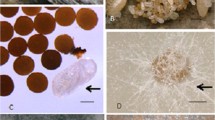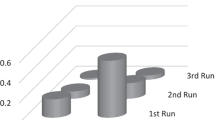Summary
Ancistrotermes guineensis (Silv.) colonies were reared in observation nests The timetable of development of the young colony is given. The construction of fungus comb from the faeces of the worker caste was observed; chewed wood was not used is constructing the comb. The fungus comb remained sterile until the correct species ofTermitomyces was introduced. The symbiosis between termite and fungus would appear to be specific. It seems that the alates do not carry an inoculum of viable spores of the fungus from the parent colony, but that workers introduce basidiospores in early foraging. This may be an important factor controlling the abundance of the termites. The phylogeny of the Macrotermitinæ is reviewed in the light of the new evidence.
Résumé
Quelques colonies d'Ancistrotermes guineensis (Silv.) ont été élevées dans des nids sous verre pour en faciliter l'observation. La table chronologique du développement de la nouvelle colonie est donnée. On a observé que seule la matière fécale était utilisée pour la construction des meules à champignons et que les termites ne se servaient pas du bois maché. Les meules demeurèrent stériles jusqu'à l'introduction de l'espèce correcte deTermitomyces. La symbiose entre les termites et les champignons paraît être spécifique. Il semble que les essaimants ailés ne transportent pas d'inoculum de spores vivantes de la colonie d'origine et que les ouvriers les introduisent lors des premières récoltes à l'extérieur. C'est peut-être là un facteur important qui règle l'abondance des termites champignonnistes. La phylogénie des Macrotermitinæ doit être reconsidérée en fonction de cette nouvelle évidence.
Zusammenfassung
Die Kolonien vonAncistrotermes guineensis (Silv.) waren in Beobachtungsnestern gezüchtet. Die wichtigsten Daten in der Entwicklung der jugen Kolonie ist gegeben. Die Konstruction der Pilzgarten aus dem Kot der Arbeiter wurde beobachtet; gekautes Holz wurde nicht für den Bau benutzt. Der Pilzgarten blieb sterile bis die richtige Art vonTermitomyces eingeführt wurde. Es ist wahrscheinlich, dass dei Symbiose zwischen Termiten Art und Pilz specifich ist. Es scheint als ob die Geflügelten beim Ausschwärmen von der ursprünglichen Kolonie nicht Pilz Basidiosporen mitnehmen, sondern dass die Arbeiter sie beim ersten furagieren einschleppen. Diese Tatsache könnte in der Kontrolle des Ueberflusses von Termiten sehr wichtig sein. Die Phylogenese der Macrotermitinae ist im Lichte dieser neuen Evidenz besprochen.
Similar content being viewed by others
References
1927a.Bathellier (J.). — Observations sur les mœurs des termites indochinois, leurs habitations, leurs moyens de défense, etc. (Faune Colon. franç.,1, 184–218).—Bathellier (J.). 1927b. Les cultures mycéliennes des termites de l'Indochine (Ibid. Faune Colon. franç., 333,366).
1946.Coaton (W. G. H.). — The Harvester Termite Problem in S. Africa (Bull. Dept. Agric., Pretoria,292, 1–38).
1928.Emerson (A. E.). — Termites of the Belgian Congo and the Cameroons (Bull. Amer. Mus. nat. Hist.,57, 401–574).
1937.Grassé (P. P.). — Recherches sur la systématique et la biologie des Termites de l'A. O. F., 1re partie (Ann. Soc. ent France,106, 1–100).—Grassé (P. P.). 1944–45. Recherches sur la biologie des Termites champignonnistes (Macrotermitinæ), 1re partie (Ann. Sci. nat. Zool.,11 (6), 97–172).—Grassé (P. P.). Ditto, 2me partie (Ibid. Ann. Sci. nat. Zool.,11 (7), 115–146).
1950.Grassé (P. P.), Heim (R.). — UnTermitomyces sur meules d'unAncistrotermes Africain (Rev. sci. Paris,88 (1), 3–13).
1948.Grassé (P. P.), Noirot (C.). — Sur le nid et la biologie duSphaerotermes sphaerothorax (Sjöstedt) (Ann. Sci. nat. Zool.,11 (10), 150–164.—Grassé (P. P.), Noirot (C.). 1951. Nouvelles recherches sur la biologie de divers Termites champignonnistes (Macrotermitinæ) (Ann. Scinat. Zool.,11 (13), 291–342).—Grassé (P. P.), Noirot (C.). 1955. La fondation de nouvelles sociétés parBellicositermes natalensis (Hav.) (Insectes Sociaux,2 (3), 213–220).—Grassé (P. P.), Noirot (C.). 1957. La signification des meules à champignons desMacrotermitinæ (Ins., Isoptères) (C. R. Acad. Sci., Paris,224, 1845–1850).—Grassé (P. P.), Noirot (C.). 1958a. La meule des Termites champignonnistes et sa signification symbiotique (Ann. Sci. nat. Zool.,11 (20), 113–127).—Grassé (P. P.), Noirot (C.). 1958b. Construction et architecture chez les Termites champignonnistes (Proc. X. Int. Congr. Ent.,2, 515–520).—Grassé (P. P.), Noirot (C.). 1959. L'évolution de la symbiose chez les Isoptères (Experientia,15 (10), 365–372).
1912.Holmgren (N.). — Termitenstudien III. Systematik der Termiten die Familie Metatermitidae (K. svenska Vetensk. Akad. Handl.,48 (4), 107–136).
1934.Kemner (N. A.). — Systematische und Biologische Studien über die Termiten Javas und Celebes' (K. svenska Vetensk. Akad. Handl. Ser. 3 13 (4), 1–241).
1955.Kemp (P. B.). — The Termites of N. E. Tanganyika: their distribution and biology.Bull. ent. Res.,46 (1), 113–135).
1955.Light (S. F.), Weesner (F. M.). — The incipient colony ofTenuirostritermes tenuirostris (Desn.) (Insectes Sociaux,2 (2), 135–146).
1949.Luscher (M.). — Continuous Observation of Termites in laboratory cultures (Acta. trop., Basel,6, 161–165.—Luscher (M.). 1951. Beobachtungen über die Kolonie-gründung bei verschiedenen afrikanischen Termitenarten (Acta. trop., Basel,8, 36–43).
1956.Sands (W. A.). — Factors affecting the survival ofOdontotermes badius (Hav.) (Insectes Sociaux,3 (4), 531–536).
1911.Sjostedt (Y.). — Zur Termiten fauna Kongos (Ent. Tidskr.),32 (3–4), 37–70).
1959.Williams (R. M. C.). — Colony development inCubitermes ugandaensis (Insectes Sociaux,6 (3), 292–304).
Author information
Authors and Affiliations
Rights and permissions
About this article
Cite this article
Sands, W.A. The initiation of fungus comb construction in laboratory colonies ofAncistrotermes guineensis (Silvestri). Ins. Soc 7, 251–263 (1960). https://doi.org/10.1007/BF02224496
Issue Date:
DOI: https://doi.org/10.1007/BF02224496




